The theme of the 8th annual Lancaster Water Week is Rewilding for Clean Water. Rewilding is all about conserving, restoring, expanding, and connecting natural spaces. Replacing lawn with native trees, shrubs, and flowers at your home or place of worship is one way to rewild. Replanting forested buffers along streams at farms or corporate campuses is another example of rewilding.
Native plants help absorb and clean water while also providing food and shelter for wildlife like birds and insects. When we rewild, we are protecting the health of our streams, environment, and community!
Rewilding can take many different forms on various scales – from a flowerpot to an entire landscape – in various locations – such as your backyard, a farm, a corporate campus, or a nature preserve. This Water Week, Lancaster Conservancy and our partners are celebrating it all!
Rewilding Farms
By Chandra Crosson, Lancaster Farmland Trust
Years ago, it was common for farmers to allow their livestock to graze in the wooded areas of their farms. However, due to a lack of management, farmers began to see the degradation of soil health, regeneration, and tree health on their property. Soon, farmers moved their animals to grassland pastures, as we often see today. However, recent studies show numerous benefits to allowing cattle to graze near trees and shrubs. So, how can farmers participate in silvopasture practices without negatively impacting the health of their land?
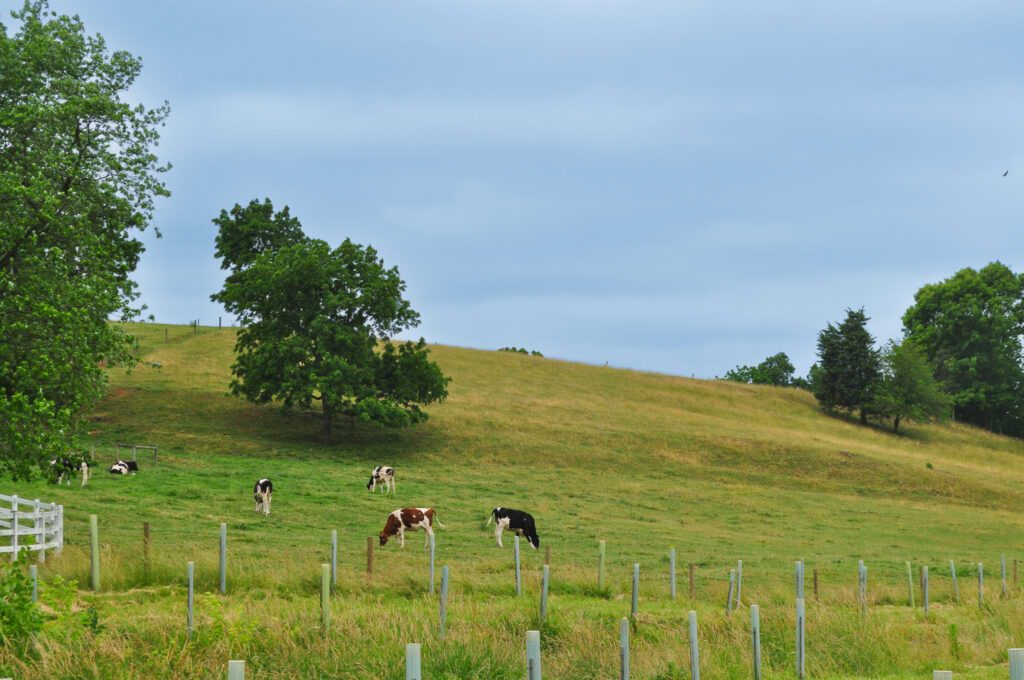
Silvopasture in action (Photo courtesy of Lancaster Farmland Trust)
Today, there are experts who specialize in silvopasture integration to help farmers determine which areas of their land would work best for silvopasture. Silvopasture practices require balance: the land can’t be too wet or dry. Other factors also play a significant role, such as animal type, soil type, and the amount of land. Farmers with more space to rotate their animals in and out of a silvopasture are likelier to have healthier land, as the pasture will have time to rest and recover from animal use.
Silvopasture integration has numerous benefits, such as improved water quality, healthier livestock, and increased biodiversity. Open pastures that do not integrate trees are more likely to produce soil erosion and stormwater runoff. Adding trees to pastures provides the soil with a layer of protection from pounding rain, improving water quality. Plus, this integration allows the land to support a unique mix of animals: grassland animals, woodland animals, and animals that require a mix of both.
Dive Deeper
Rewilding Urban Environments
By Molly Deger, City of Lancaster
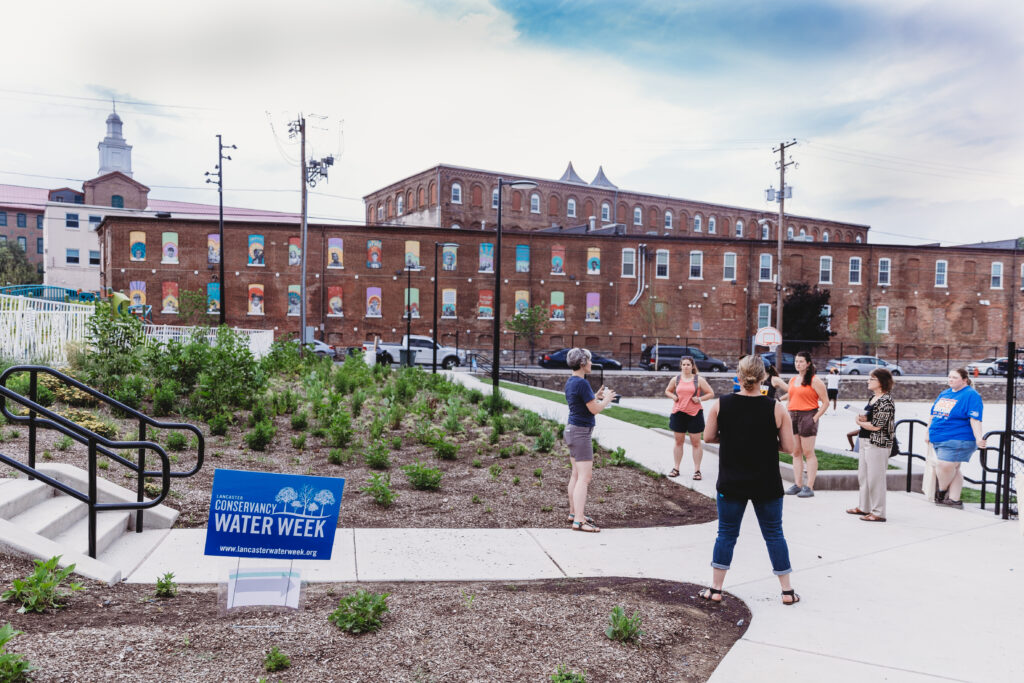
A 2021 Water Week event explored rain gardens in a Lancaster City park (Photo by Michelle Johnsen)
Rewilding in the urban setting is critical to meeting water quality goals in Lancaster City. By implementing green infrastructure, increasing our tree canopy, and planting absorptive landscapes, stormwater and associated pollutants are removed from the combined and separate sewers, and we can also promote resiliency, reduce urban heat island effect, improve air quality and other public health benefits, create beautiful open space and an increase in natural resources to the urban community, increase property value, and create green jobs. But rewilding a dense city such as Lancaster must be done thoughtfully and equitably through careful planning and with a strong emphasis on community engagement at every step of the way.
There are both real and perceived threats to rewilding in the urban setting. For example, tall meadow grasses have incredibly deep root systems that are powerhouses for clean water, but can decrease visibility for pedestrians, making community members feel unsafe. To help alleviate this concern, the City has adapted to using meadow grasses that will not typically grow more than waist high. Another consideration that’s especially important in the urban setting is the wildlife component; rain gardens and wildflower meadows attract beneficial pollinators such as butterflies and hummingbirds, and when properly maintained should not attract nuisance pests like mosquitoes and rodents. The City prides itself in its maintenance regime, but like all asset management, there may be times that additional action is warranted for our native landscapes such as pest control treatment or revisiting a plant selection for certain sites. This reiterates the need for continued engagement to show our community what we’re doing to address challenges.
Lancaster City will not falter in its commitment to rewilding in the urban setting, but will continue to engage and learn with our community, through the many successes and challenges, to adapt to a changing City and changing environment.
Dive Deeper
Rewilding Corporate Campuses
By Chrissy Leslie, Eurofins
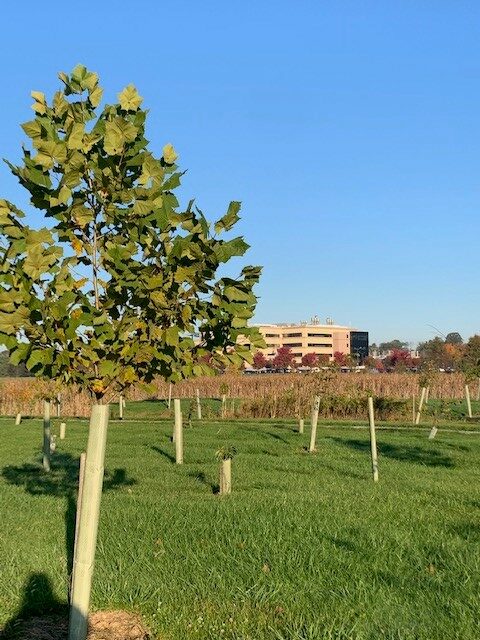
Eurofins riparian buffer (Photo courtesy of Eurofins)
At Eurofins, we believe it is critical to nurture and support biodiversity and clean water on our campuses by creating and protecting natural habitat. Over the past eight years, we have focused efforts on moving away from traditional landscaping to creating wilder spaces that foster native plants and create healthier ecosystems for the wildlife that shares our campus. We are removing invasive species such as Bradford pear trees, burning bush, and Japanese barberry and replacing these with Pennsylvania native trees and shrubs such as red twig dogwoods, summersweet, and Eastern redbuds.
The Lancaster, Pennsylvania site has three key areas dedicated to this mission. Over 7 acres of land are protected and restored on the property. These spaces are maintained by community partners and employee volunteers (e.g. Green Team, Garden Club).
- In 2022, a 12,880-square-foot rain garden was installed in collaboration with LandStudies. This replaced a grassy lawn area and now helps to protect water by filtering out pollutants from a nearby farm and creates habitat for pollinators, birds, and other wildlife.
- In 2019, over 1,000 Pennsylvania native trees and shrubs were planted in partnership with the Alliance for the Chesapeake Bay creating a riparian buffer along a nearby stream. The area also has a walking trail for employees and the local community to enjoy.
- In 2016, a native pollinator garden was implemented as part of the company vegetable garden. This garden space is registered through the S.H.A.R.E. Partnership’s Million Pollinator Garden Challenge. This challenge campaigned to register a million public and private gardens and landscapes to support pollinators. The goal was surpassed in 2019.
Rewilding Sacred Spaces
By Mike Hudson, Interfaith Partners for the Chesapeake
When a faith community comes to Interfaith Partners for the Chesapeake (IPC), rewilding is not usually what is on their mind. Or at least, they wouldn’t use that term to describe what they want to do! More often, congregations are trying to solve problems involving flooding or erosion, or maybe they have a group of energetic congregants who want to engage with Creation Care. But what many soon learn, as they work through their challenges and learn about stewarding their properties with care, is that inviting wilderness into their faith communities is one of the most natural things they can do.
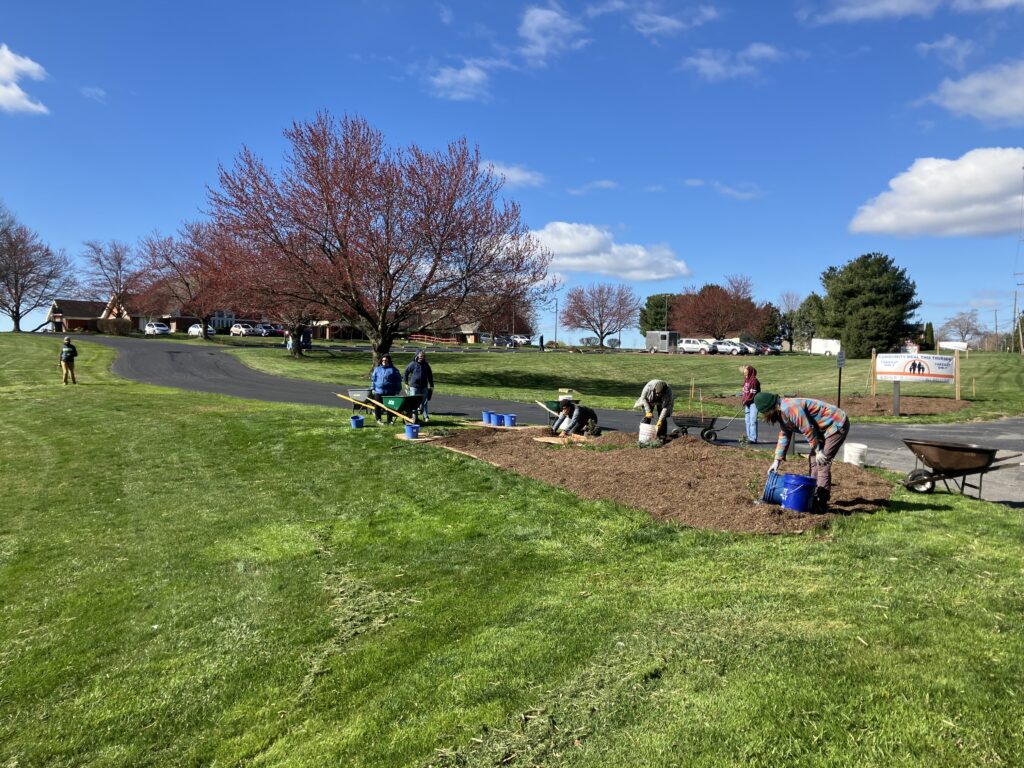
Meadow installation at Ascension Lutheran Church (Photo by Mike Hudson)
There is no one approach for a faith community that wants to think about rewilding their campus. At the extremes, some congregations sit on large plots of land with big lawns and parking lots, and others are tucked amongst high rises in urban downtowns. Some congregations that IPC works with can support rather large restoration projects, like the riparian buffers at Rader Park, maintained by Church of the Apostles, United Church of Christ; and the ongoing riparian buffer and pollinator meadow installations at Ascension Lutheran Church. Even faith communities with smaller campuses often find ways to set aside some space for a rain garden or other green, natural features. These physical projects, large and small, are probably what many of us think of as backyard rewilding and congregations quickly recognize that bringing back native plants and insects and birds is an unexpectedly joyful part of their installation and one they want to take further. Several partner congregations are now adding exciting features like bluebird trails and bat boxes to their campuses and exploring other ways to invite wildlife and native plants back.
I think that one of the most important things that these congregations do, however, is showing their communities how to reconnect with the natural world. Listening to birdsong and mindful meditation in woodlands are just two activities that both connect us to the natural world and have been shown to have tangible health benefits, like lowering blood pressure. Imagine then, going to walk the labyrinth at a local church and weaving among native wildflowers; or an evening worship service under tall, leafy trees, fireflies dancing in the gathering gloom. What better way is there to show people that we are not separated from the natural world, but we ourselves are a part of the wilderness. Let’s invite the wild back into our homes and our hearts.
Dive Deeper
- Turn Your Garden Into a Pollinator Paradise Learning Lab
- Congregation Restoration Project Maintenance Guide
- Action Kits: Blessing a Waterway
- Action Kits: Planting Native Plants
- Water Week Event: One Water Partnership Lunch & Learn
- Water Week Event: Sacred Habitats Nature Walk at Hope Episcopal Church
- Water Week Event: Sacred Habitats Nature Walk at Church of the Apostles United Church of Christ
Rewilding Communities
By Larry Guengerich, Landis Communities
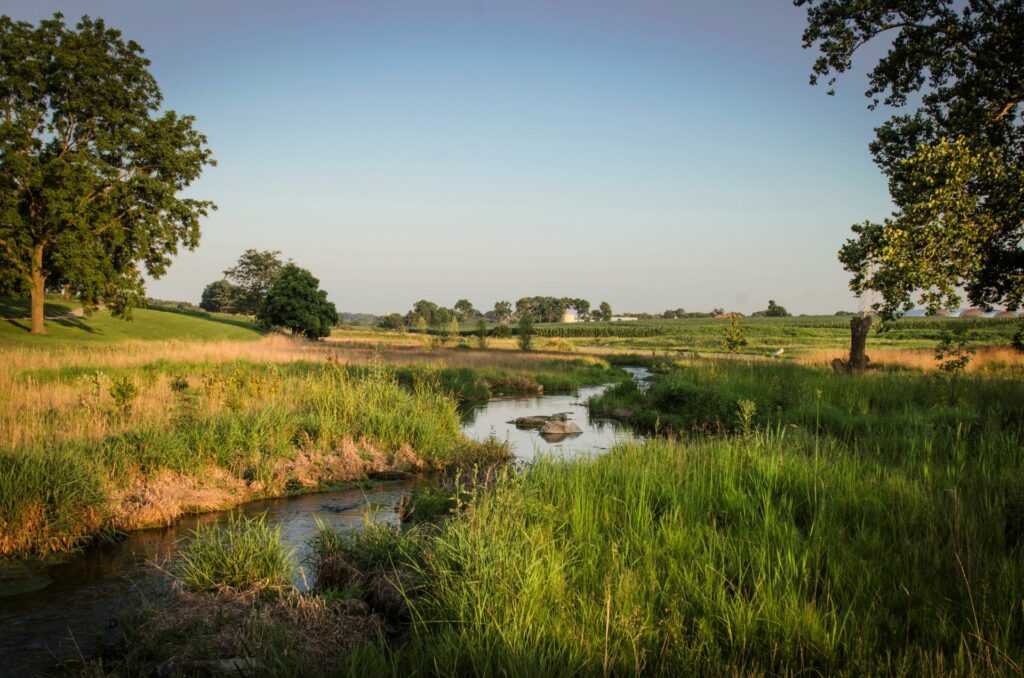
Landis Homes stream after restoration (Photo by RGS Associates)
At Landis Homes, we’ve re-established natural wetlands, significantly reducing pollution and benefiting local rivers and the Chesapeake Bay. It’s all part of our commitment to stewardship and caring for God’s creation.
Rewilding provides a range of benefits, with improving water quality being one of the most significant. Rewilded areas feature native vegetation, which acts as a natural filter. These plants trap pollutants and sediments that would otherwise flow into waterways. Wetlands absorb excess nutrients, preventing them from reaching water sources. Floodplains act as natural sponges, reducing the risk of flooding and filtering out contaminants.
In addition, the resulting habitat provides a home for diverse organisms, including bacteria, fungi, and insects. These organisms play a crucial role in breaking down pollutants, further improving water quality. Each year this effort removes approximately 800 pounds of phosphorus and up to 75 tons of sediment. It also allowed for the removal of a number of detention basins, creating space for 11 additional cottages, built to LEED Gold standards.
Dive Deeper
Rewilding Landscapes
By Keith Williams, Lancaster Conservancy
Rewildling nature preserves sounds kind of silly, right? They are nature preserves, so they are wild. But are they native wild? In the east, probably not.
There are multiple benefits of land protection: clean air and water produced by a landscape covered in vegetation; nutrient cycling (where materials are recycled from dead material to living and back again – a kind of resurrection and reincarnation); pollination (much of our food production is dependent on native pollinators who depend on protected habitat); and biodiversity conservation. Biodiversity is the different kinds of life in an area, and that drives all the other ecosystem services (clean air, water, nutrient cycling, pollination, etc.).
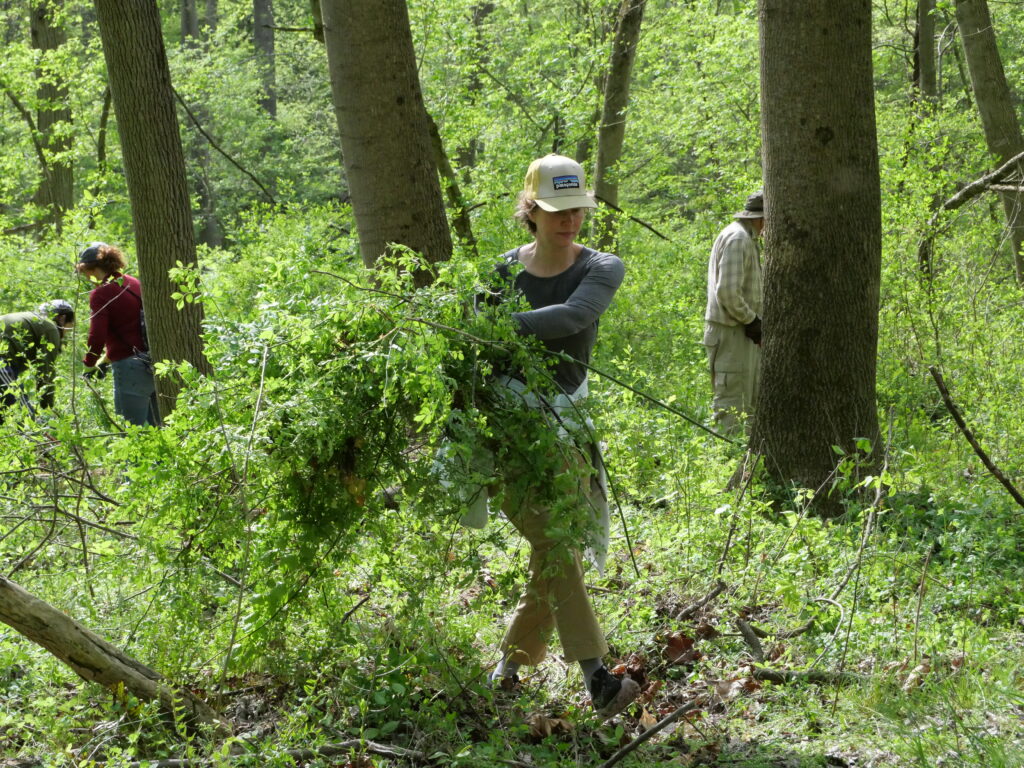
Invasive multiflora rose removal at Climbers Run Nature Center (Photo by Avery Van Etten)
However, most of our ecosystems in the eastern United States have been impacted by invasive species. Invasives are species typically from another continent, introduced into new ecosystems for the organism, which means the typical population controls like diseases and predation (or herbivory) aren’t there to keep their numbers in check. Their populations can grow exponentially, and they outcompete native organisms for resources like food, water, sunlight, and nutrients. Their net effect is a reduction in the biodiversity we are trying to conserve by protecting land in the first place. And since the invasives reduce biodiversity, ecosystem functions we depend on suffer. Because the invasives are new additions to the landscape, the eons-old relationships between different beings in the landscape are missing. The ecosystem – all the beings in the place, the plants, insects, reptiles, amphibians, birds, mammals – suffer.
Often the first step to rewilding our preserves is to remove the invasives, followed by planting native trees, shrubs, wildflowers, and grasses. It’s an overwhelming task, one that couldn’t be accomplished without the hard work of hundreds of volunteers. And just like the collective action of hundreds of volunteers is what restores biodiversity on our preserves, regional biodiversity will be protected and restored in the same way – by individuals doing the next right thing for the part of the Earth they are stewarding in their time here, whether that is planting a container full of milkweed or a 5-acre native meadow. If we all took care of our part of the world, there wouldn’t be any part of the world needing care.
Dive Deeper
- Protecting the Susquehanna Riverlands Conservation Landscape
- Ecological Restoration 101: What It Is & Why We Do It
- Native Trees Protect Healthy Waterways
- Water Week Event: Shiprock Woods Restoration Project Tour
- Water Week Event: Clean Water Meadows at Clark Nature Preserve
- Water Week Event: Project Clean Communities
Rewilding Your Home
By Linda Ferich, Lancaster Conservancy
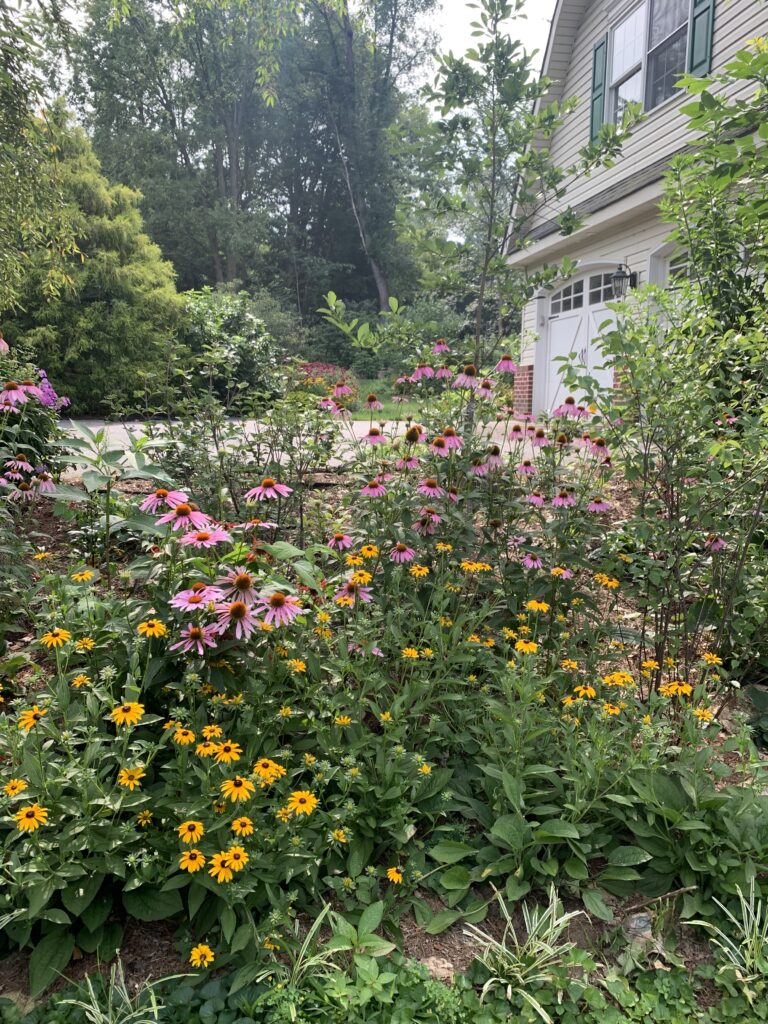
Example of a pollinator friendly garden you could create in your yard (Photo by Lisa Doseff)
Rewilding a home landscape to provide habitat and control stormwater has become a conservation movement. Native plants are an essential part of restoring ecosystems and increasing biodiversity on our properties.
With the decline of pollinators, birds, and other wildlife, many have become inspired to design beautiful, sustainable gardens. Ecological gardens can slow down stormwater, filtering pollutants and improving stream quality. The practices that we use in our gardens can affect our watersheds and life existing in all bodies of water.
For ecological gardening practices, here are just a few things to consider:
- Start small. Even native plants in a container can make a difference. Over time, increase the habitat on your property.
- Learn about biodiversity and why different layers in your landscape are important. The layers are canopy trees, understory trees, shrubs, perennials, and ground cover.
- Observe the light and moisture conditions so you are using the correct native plant for those conditions.
Creating ecological gardens on our properties to help wildlife and control stormwater can help to revitalize ecosystems that support all life!
Dive Deeper
- Habitat Advocate Certification
- Community Wildlife Habitat & Native Gardening Resources
- Water Week Event: Get a free native tree, shrub, or wildflower seeds during First Friday in Penn Square and other events throughout Water Week!
- Water Week Event: Experience the Upper Conestoga: Connecting with Our River
- Water Week Event: Clean Water Meadows
Join these partners and others during Lancaster Water Week from June 7-15, 2024, to celebrate our streams and rivers with over 60 events! Learn more at lancasterwaterweek.org.
